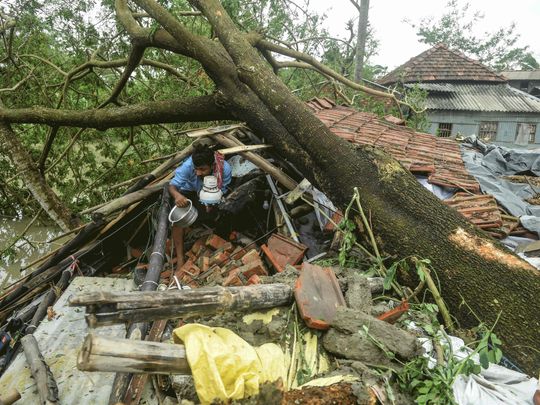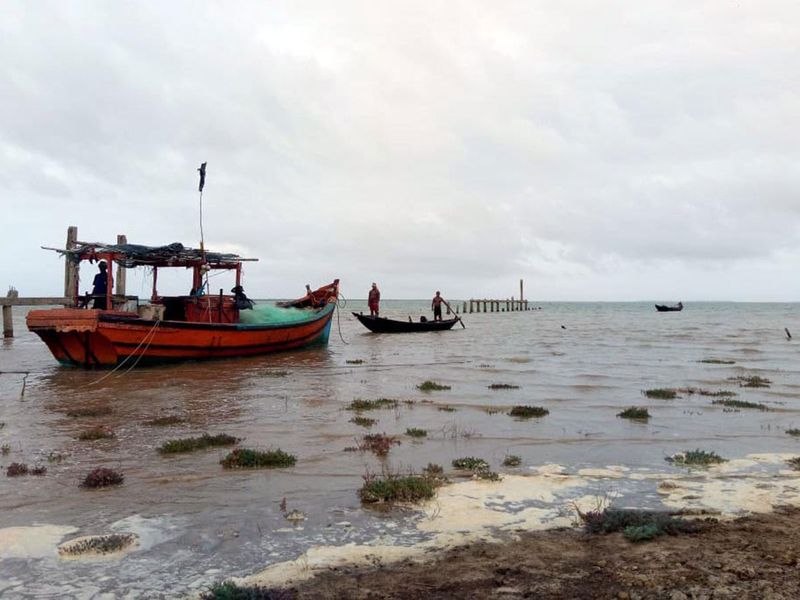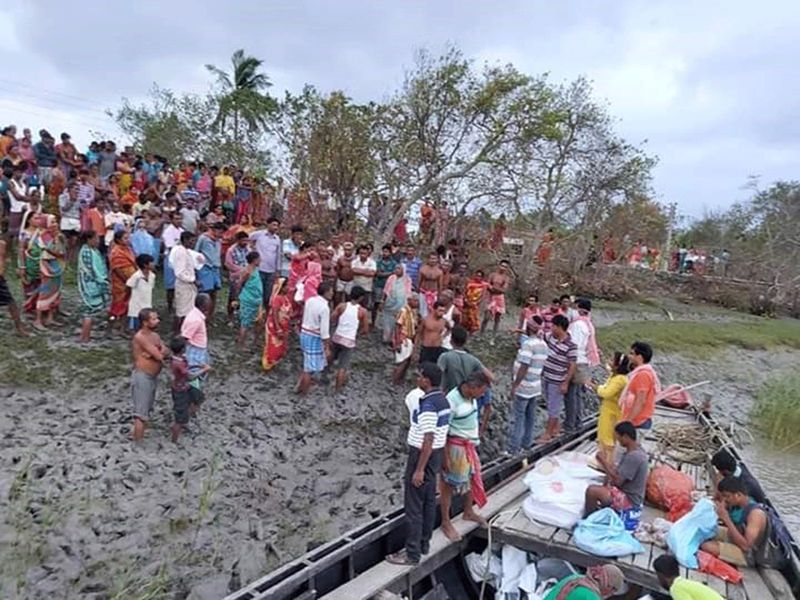
Dubai: Affected population: 800,000-plus.
Houses damaged: 2.86 million approximately.
Crop-area damaged: 1.7 million hectares approximately.
Other damages: Embankments, roads, irrigation canals, drinking water facilities, education and health infrastructure.
Loss of lives: 118
Total estimated damage: $13.6 billion (Dh50 billion)
The figures are simply staggering as nearly a month-and-a-half after super cyclone Amphan struck West Bengal on May 20, the eastern Indian state is still trying to limp back to normality. Kolkata, the state capital, still shows the odd scars here and there as the storm had flattened thousands of trees — but the scenario is still grim in other three of it’s worst-affected districts.
The Sunderbans, the largest mangrove forest in the world spread across 4,260 square kilometres and with an active delta across the districts of South and North 24 Parganas, got the unkindest cut from Amphan — as it always happens in the aftermath of such cyclones. At least four of the sub-divisions — Gosaba, Sandeshkhali, Hingalganj and Minakhan — still bear the look of vast sheets of water. As the banks gave way, river water flooded acres and acres of agricultural land and salinated them, destroying the potential of cultivation there for at least two seasons.
Thousands of families are still holed up in the shelter houses, which the state government had built in the wake of Cyclone Aila in 2011, the worst tropical storm to have struck the state in living memory — until Amphan came. Several hundreds have lost their homes, livestock and cultivable lands in these two districts, along with Howrah, and have just begun piecing together their lives upon receiving a modest government grant of Rs20,000 (Dh1,000) per family to rebuild their homes.
“I have never seen such a cyclone in my life”, a visibly shattered Mamata Banerjee, the Chief Minister of West Bengal, said in Nabanna — the administrative headquarters of the government — as details of the damage were filtering in on that fateful May evening.

There was no record of a cyclone with wind speed as high as 185km/hour when making landfall on the coast of Bengal in recent times. It was not only the intensity of the storm that made the event significant, but also its duration — the wall cloud stayed for almost five to six hours.
It was in early June that an Inter-Ministerial Central Team (IMCT) from New Delhi visited the state to assess the damages — which the state government estimated to be in the region of Rs1.02 trillion. “The central government had released Rs10 billion soon after Prime Minister Narendra Modi’s visit following the cyclone. However, we are yet to hear anything by way of a follow-up since then,” said Subrata Mukherjee, the veteran state minister in-charge of Panchayat (local self-government).
A major trouble-shooter for ‘Didi,’ as CM Banerjee is popularly known, Mukherjee said the government was prioritising re-building the homes of families in the three worst-affected districts. “We are giving out an ex-gratia from the chief minister’s Abash Yojona, while the West Bengal Housing Development Corporation is also helping out with their resources.
“At this juncture, we are addressing the immediate needs like giving back the roof over their heads, helping out the farmers so that they are equipped to start harvesting the ‘kharif’ season crop in the monsoon. A lot remains to be done though,” Mukherjee told Gulf News over the phone.
At this juncture, we are addressing the immediate needs like giving back the roof over their heads, helping out the farmers so that they are equipped to start harvesting the kharif season crop in the monsoon. A lot remains to be done though
However, more than 40 days after the storm, the distribution of relief funds has become a hugely contentious issue, with complaints emerging that there were several cases of those owing allegiance to the ruling party, Trinamool Congress, walking away with the cheques, though there were no damages to their homes and hearth, while genuine cases have been left languishing. With state elections coming up next year, Opposition parties such as the Bharatiya Janata Party (BJP), Congress and Communist Party of India-Marxist (CPIM) have raised the pitch in the media and on TV talk shows.
Admitting that there had been some misappropriation of funds, a senior government official said the percentage is “very low” and they have also refunded the money in some cases.
Pradip Mazumdar, Special Advisor to the Chief Minister on Agriculture and other allied sectors, said over the phone: “The job of allocation was left to the district administration and a small percentage of cases has been reported. A visit to the affected blocks will show that the rebuilding of houses is being carried on in full swing. But the Opposition parties have made a big deal of it.”
Giving a lowdown on the way the government is working to resume the means of livelihood for the farmers, Mazumdar further said: “Following Aila, harvesting suffered for at least two seasons with salt water entering the cultivable lands. This time around, we have initiated the required technology to restore such areas immediately with 500 tonnes of salt-tolerant seeds while distribution of 1,800 tonnes of bio manure to the farmers is now on. With monsoon already arriving, it’s a race against time to ensure that they can go back to their means of livelihood.”
NGOs to the fore
Cyclone Amphan came as a double blow for the state, which had come under the scanner for it’s handling of the COVID-19 pandemic, with Opposition parties accusing the Banerjee-led government of not conducting enough tests and even manipulating casualty figures. However, as if to rise to the severity of the challenge, a number of NGOs had been playing an exemplary role in terms of mobilising funds and reaching out to the affected areas with relief material — along with a plan for the future.

Conspicuous among these NGOs is the Quarantined Students Youth Network (QSYN), a network of students’ community based out of Jadavpur University. In case you are wondering about the ‘Quarantined’ component, the body was born during the initial months of the nationwide lockdown over the COVID-19 pandemic, with an aim to reach out to various corners of the state with supply of essential items, foodstuff and medical supplies.
“Fortunately, we had a system in place and built up 70 per cent of the supplies at the Jadavpur University premises. Soon after May 20, our boys fanned out to the two 24 Parganas (primarily Sunderbans), East Midnapore, Kolkata and Howrah districts. We actually managed to reach some of the remote islands of Sunderbans,” said Manmatha Roy of QSYN.
The students community-run 'social initiative,' as they call themselves, rushed to the spot with 3,035 tarpaulin sheets, provided 8235 families with ration while their community kitchen had been feeding thousands of affected people so far. Going forward, Roy, an MTech student with Indian Statistical Institute, said their plan is to now look at a two-point agenda to help with the rehabilitation. “Over the last 10-15 days, our teams have stationed themselves at three of the worst-affected blocks in Sunderbans with an aim to help out the local community in search of a future livelihood. We are helping them to de-salinate the ponds with chemicals so that they can resume the sweet water fish cultivation,” Roy said over the phone.
Solution for Sunderbans?
“Amphan will not be the last cyclone for the Sundarbans,” Tuhin Ghosh, Professor and Director of the School of Oceanographic Studies, Jadavpur University, said in a recent interview. History shows that between 1901 and 2012, the Sundarbans saw 367 depressions, 68 storms and 77 cyclones, while between 1999 and 2019, the number of prominent cyclones in Bay of Bengal was 32.
This huge hinterland that stretches across two districts and acts as a buffer for both West Bengal and Bangladesh against cyclones, is an active delta region where the river levels continue to rise dangerously from time to time with siltation — overflowing the embankments and flooding the adjacent regions. There have been cases of whole islands being lost under the water.
“The need of the hour should be to formulate a comprehensive policy for mitigation through risk minimisation, resilience-building and preparedness to respond to such events,” Ghosh said. “West Bengal should follow the example of Odisha,” he said, where the state had been on a learning curve after the super cyclone of 1999.
How prepared, then, is West Bengal to prevent another disaster of the magnitude of Amphan or even less? The disaster management teams of the state have taken a cue from their past experiences about timely warnings and evacuation of people from the low-lying areas — with them minimising the loss of human lives by evacuating more than 150,000 people ahead of Amphan.
The problem of Sunderbans, however, remains, which can be marginally mitigated with making all the embankments concrete instead of the endless brick-and-mud structures. Agreeing to the idea, minister Mukherjee said: “The percentage of concrete embankments has been increased, wherever it’s technically possible. We have also approached the World Bank for funds and are looking to fortify them.
“There has been a 20-30 per cent increase in the frequency of moderate storms with a wind speed of 60-80km/hr in recent years, while storms in the region of 120-130 km/hr are once-in-a-season occurrences. It’s a battle without no permanent solutions, but we have to be ready,” he added.
A timeline of major cyclones in the Bay of Bengal
1970 Bhola: A devastating tropical cyclone that struck the erstwhile East Pakistan (now Bangladesh) and West Bengal on November 3, 1970. It remains the deadliest tropical cyclone ever recorded in India with an approximate fatality of 500,000.
2009 Aila: Aila was the second named tropical cyclone of the 2009 North Indian Ocean cyclone season. Warned by both, the Regional Specialised Meteorological Centre and Joint Typhoon Warning Centre, Aila wreaked havoc in West Bengal and Bangladesh with a fatality of 339.
2015 Komen: Cyclonic Storm Komen was an unusual tropical cyclone that originated near the southern coast of Bangladesh and later struck the same country while drifting over northern Bay of Bengal. The second named storm of the 2015 season, Komen brought several days of heavy rainfall to Myanmar, Bangladesh and India with fatalities between 187–280.
2019 Fani: It was the strongest tropical cyclone to strike Odisha since the 1999 Odisha Super Cyclone and also affected West Bengal, with a fatality count of 89.
2020 Amphan: Super cyclonic storm Amphan was a powerful and deadly tropical cyclone that caused widespread damage in eastern India, specifically West Bengal, and also in neighbouring Bangladesh in May 2020. It recorded a highest wind speed of 260km/hr and a total fatality count of 118.








